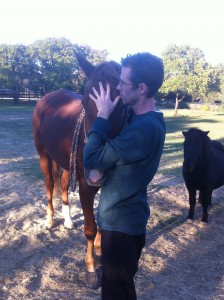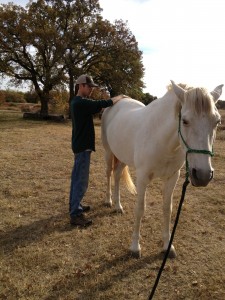And Allah took a handful of southerly wind,
blew His breath over it, and created the horse.
He said to the magnificent creature,
“I have made thee as no other.
All the treasures of the earth lie between thy eyes …
Thou shall fly without wings,
and conquer without any sword.”
~ Bedouin Legend
 Shea Stewart of Stewart Equine Craniosacral recently invited me out to enjoy the great outdoors and try my hand at craniosacral work with horses. I was a little nervous at first, but I must say that the day went very well. After so many years of working with the human body on a daily basis, shifting to a larger animal was extremely interesting to say the least. I will share a few initial insights I had today while in contact with these majestic and sensitive beings.
Shea Stewart of Stewart Equine Craniosacral recently invited me out to enjoy the great outdoors and try my hand at craniosacral work with horses. I was a little nervous at first, but I must say that the day went very well. After so many years of working with the human body on a daily basis, shifting to a larger animal was extremely interesting to say the least. I will share a few initial insights I had today while in contact with these majestic and sensitive beings.
1) Size
At first, the most obvious difference between humans and horses is size. Wow! I immediately had to broaden my perspective of tissue structures when I started working with these animals. Shea showed me how to contact a few key cranial bones, pointed out pelvic landmarks, and clarified some diaphragm contacts. Interestingly, horses basically have the same bones as humans. They are just shaped differently and have different sutural relationships.
When I spent time monitoring the movement of osseous structures, I really enjoyed the bigger levers and larger fields of action that their cranial bones encompass. I found it very easy to palpate and flesh out the general position and motion patterns even though I was not very familiar with the details of anatomy.
Working with my hands over my head was very manageable, but I can see where it could get tiring after a long day. I noticed that the horses liked to utilize my body as a leverage point to facilitate internal correction. They would lean against me for sustained periods of time and precisely positions themselves to generate a needed fulcrum for internal correction. And this brings me to my second observation …
2) Awareness
Although size is the obvious difference between humans and horses, I came to understand that the factor that most separated horses from humans with regards to craniosacral therapy is awareness. Horses are so much more aware of external and internal space than humans. All day I had a strong sense of being watched by the horses I treated. This was not just a physical examination with the eyes. It was a careful tracking of my state of consciousness, spatial perceptual framework, and intention. All-in-all, it was the most prominent and consistent sensation I dealt with all day. I was being watched. And watched well! As I changed perceptual zones, the horse’s system immediately responded. If my mind went into a daydream, they would quickly disengage in disappointment or try to get my attention back. They would knowingly choose whether or not to respond to my directed intentions with fluids or tissues.
What was so interesting about this is that when I work in my clinic, most often the client is unaware of the process going on within their nervous system or psyche. Students develop some facility with this, but most of the general population cannot carefully track the process of state change in their internal world. The five horses I worked with today could all track their internal process and give it a lot of room to unfold. Whereas many humans cannot open the door to broader movement patterns unless they fall asleep and get their consciousness out of the way, horses can go pretty deeply into their own process and consciously get out of the way. I could distinctly track the horse pendulating its attention between my contact and their internal processes. The processes I mention might be gross soft tissue unwinding, heated transmutation of tissue density, movement toward balanced states of tension, autonomic system discharge, and even the negotiation of psychological biases towards human contact. I could clearly feel when they would go into states of remembering. This was so striking. It literally felt like the whole field around us was displaced in time as they reviewed key memories that arose during treatment.
 3) Autonomic Nervous System
3) Autonomic Nervous System
Treatment was simpler, cleaner, and more direct than it is with humans. I really came to understand today how noisy most human nervous systems are! Even in the horses with a history of episodic or prolonged trauma, there was so much quiet space within which to navigate the inherent treatment plan. The nervous systems I dealt with today were not being pushed by caffeine or high doses of sugar. The absence of these two chemicals was very noticeable to me. I know that may sound silly, but it is actually very important. Change came easier and more fluid because their nervous systems were well-versed in neutrality. Their internal accelerator was not “floored” – they could just stand there and “be.” They were not concerned about the phone, work, the economy, or the myriad other distractions to our core health that we surround ourselves with. Their natural instinct was very present and available. The absence of excessive rational thought and logistical planning was a key factor enabling them to be so direct and deep in their responses to contact.
Another interesting finding today was that only one of the five horses I worked with had remarkable autonomic issues. In humans it is the other way around – in the clinic I suspect that a full 75% of clients will have significant organic ANS dysfunction. Working with a system that is friendly to its own instinct and not drowning in ANS noise is a real pleasure, as it allows one to step immediately into the richness of processing at depth. Time seemed to slow today, and sensory life became very rich in the presence of these creatures who spend almost all of their time immersed in the soft-edged rhythms of nature.
Well, that is a few of my initial impressions of working with horses. Shea has invited me out again, and I look forward to getting to know these fascinating creatures in more detail and depth.



Pingback: Equine Craniosacral Therapy - a Conversation with Shea Stewart and Ryan Hallford - Street Smart Craniosacral